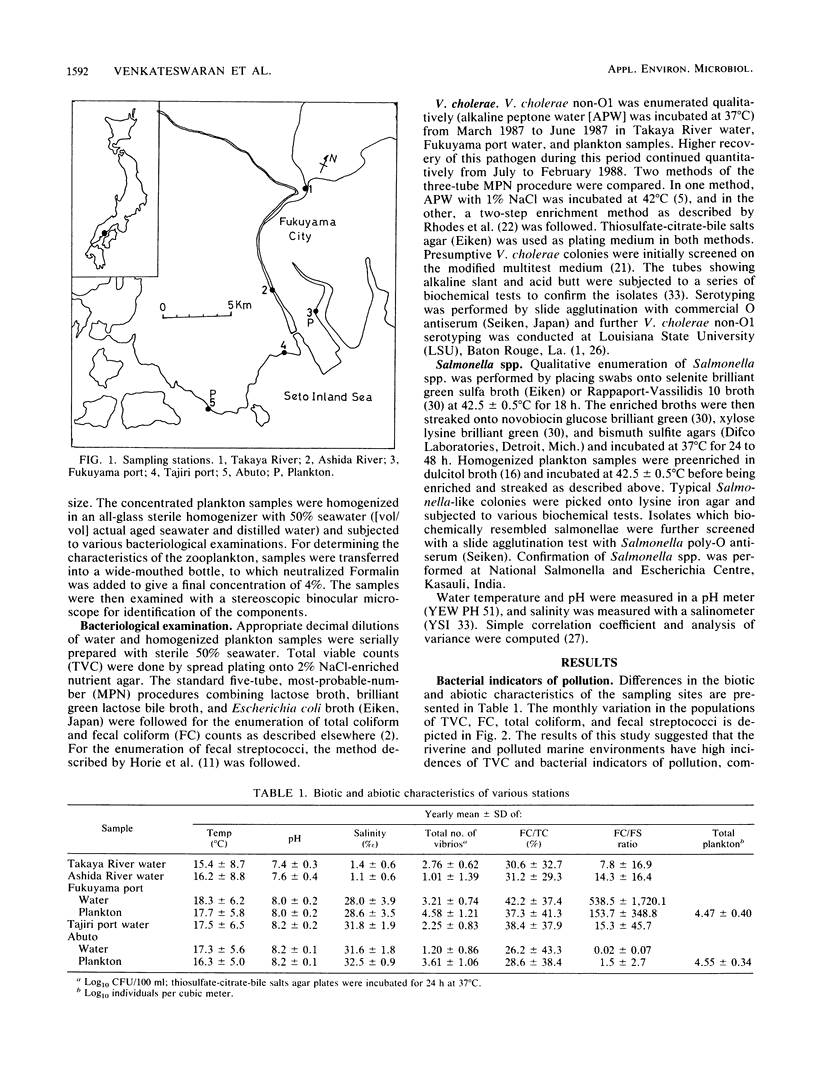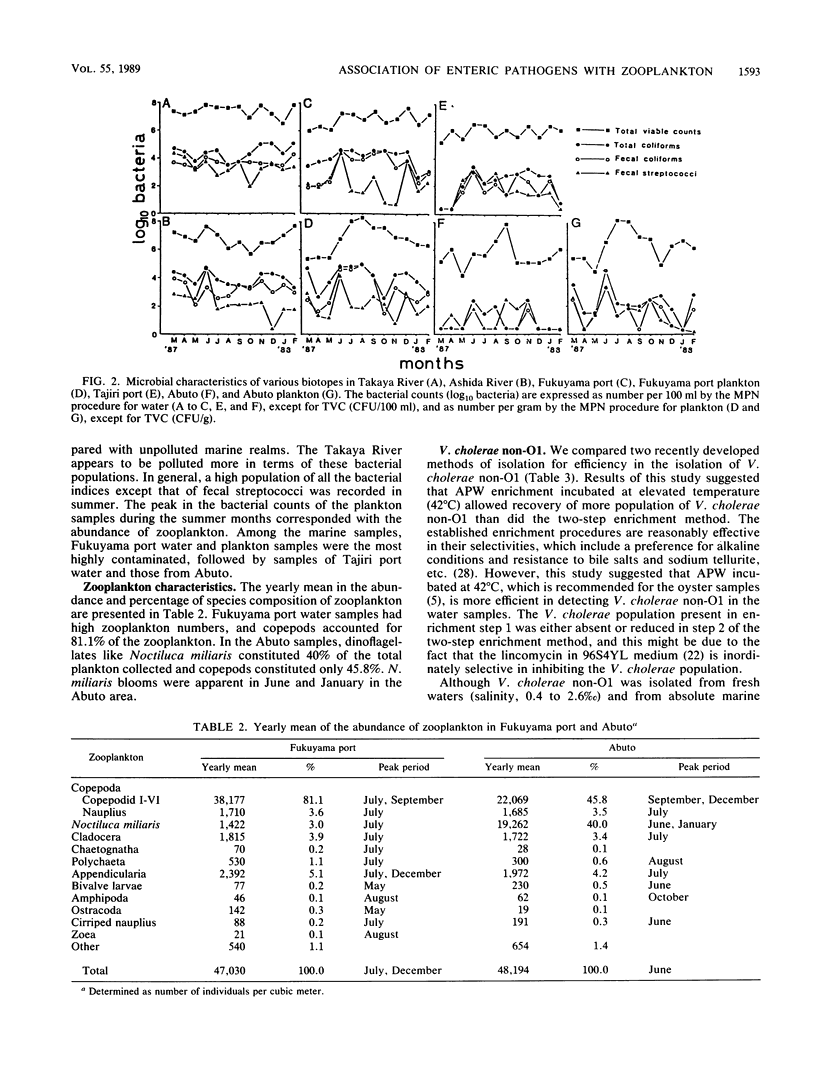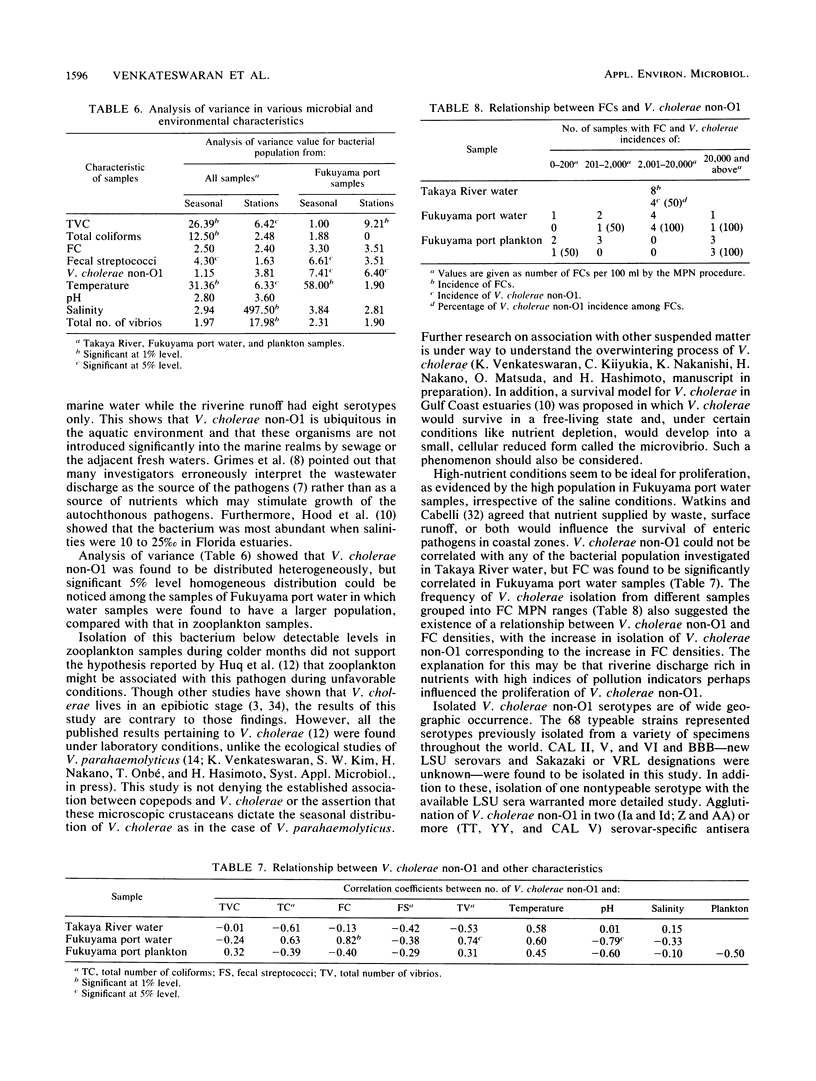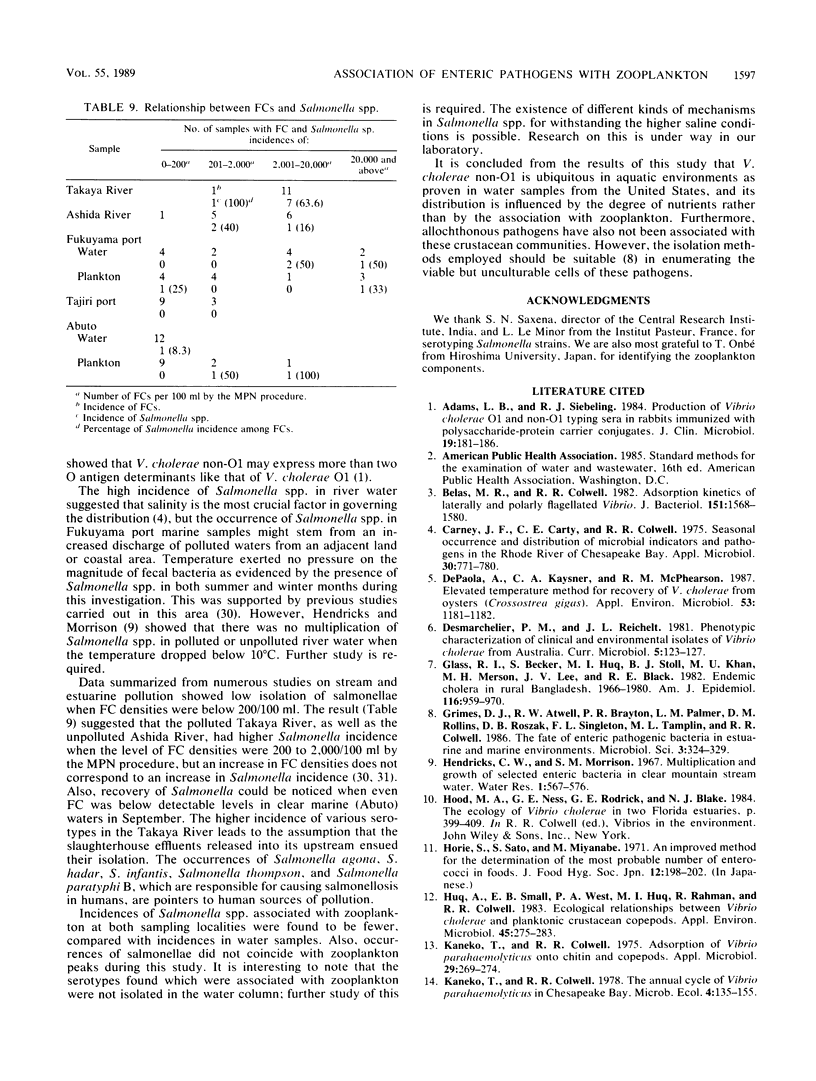Abstract
Seasonal variation of human pathogens such as Vibrio Cholerae non-01 and Salmonella spp. in Fukuyama coastal waters and the role of zooplankton in their distribution were studies for a period of 1 year. Comparison of two established methods, viz., the elevated temperature method and the two-step enrichment method of enumerating V. cholerae, showed that the former is superior in the recoveries of V. cholerae non-01. Isolation of this pathogen on a wider range of salinities (0.4 to 32.5%) revealed that these organisms are apparently an autochthonous component of the aquatic environment. Temperature appears to be the most crucial element in governing the distribution of V. cholerae non-01. Among the 69 isolates serotyped, 22 different serovars were identified, while one isolate failed to react with any of the known Louisiana State University antisera tested. Zooplankton samples did not harbor more V. Cholerae non-01 than the water column did. Better isolation of an allochthonous pathogen, viz., Salmonella spp., was noticed from the water samples when swabs were employed. Of the 251 isolates serotyped, 18 serotypes with three variants of Salmonella spp. were identified. A high amount of nutrients in the water column increased the survival rate of these pathogens in saline waters as evidenced by a higher incidence of various serotypes in polluted Fukuyama port than in clean marine waters. Salmonella spp. association between V. cholerae non-01 of Salmonella spp. with zooplankton could be noticed as influencing their seasonal distribution.
Full text
PDF







Selected References
These references are in PubMed. This may not be the complete list of references from this article.
- Adams L. B., Siebeling R. J. Production of Vibrio cholerae O1 and non-O1 typing sera in rabbits immunized with polysaccharide-protein carrier conjugates. J Clin Microbiol. 1984 Feb;19(2):181–186. doi: 10.1128/jcm.19.2.181-186.1984. [DOI] [PMC free article] [PubMed] [Google Scholar]
- Belas M. R., Colwell R. R. Adsorption kinetics of laterally and polarly flagellated Vibrio. J Bacteriol. 1982 Sep;151(3):1568–1580. doi: 10.1128/jb.151.3.1568-1580.1982. [DOI] [PMC free article] [PubMed] [Google Scholar]
- Carney J. F., Carty C. E., Colwell R. R. Seasonal occurrence and distribution of microbial indicators and pathogens in the Rhode River of Chesapeake Bay. Appl Microbiol. 1975 Nov;30(5):771–780. doi: 10.1128/am.30.5.771-780.1975. [DOI] [PMC free article] [PubMed] [Google Scholar]
- DePaola A., Kaysner C. A., McPhearson R. M. Elevated temperature method for recovery of Vibrio cholerae from oysters (Crassostrea gigas). Appl Environ Microbiol. 1987 May;53(5):1181–1182. doi: 10.1128/aem.53.5.1181-1182.1987. [DOI] [PMC free article] [PubMed] [Google Scholar]
- Glass R. I., Becker S., Huq M. I., Stoll B. J., Khan M. U., Merson M. H., Lee J. V., Black R. E. Endemic cholera in rural Bangladesh, 1966-1980. Am J Epidemiol. 1982 Dec;116(6):959–970. doi: 10.1093/oxfordjournals.aje.a113498. [DOI] [PubMed] [Google Scholar]
- Grimes D. J., Atwell R. W., Brayton P. R., Palmer L. M., Rollins D. M., Roszak D. B., Singleton F. L., Tamplin M. L., Colwell R. R. The fate of enteric pathogenic bacteria in estuarine and marine environments. Microbiol Sci. 1986 Nov;3(11):324–329. [PubMed] [Google Scholar]
- Huq A., Small E. B., West P. A., Huq M. I., Rahman R., Colwell R. R. Ecological relationships between Vibrio cholerae and planktonic crustacean copepods. Appl Environ Microbiol. 1983 Jan;45(1):275–283. doi: 10.1128/aem.45.1.275-283.1983. [DOI] [PMC free article] [PubMed] [Google Scholar]
- Kaneko T., Colwell R. R. Adsorption of Vibrio parahaemolyticus onto chitin and copepods. Appl Microbiol. 1975 Feb;29(2):269–274. doi: 10.1128/am.29.2.269-274.1975. [DOI] [PMC free article] [PubMed] [Google Scholar]
- Kaper J. B., Sayler G. S., Baldini M. M., Colwell R. R. Ambient-temperature primary nonselective enrichment for isolation of Salmonella spp. from an estuarine environment. Appl Environ Microbiol. 1977 Apr;33(4):829–835. doi: 10.1128/aem.33.4.829-835.1977. [DOI] [PMC free article] [PubMed] [Google Scholar]
- Kaper J., Lockman H., Colwell R. R., Joseph S. W. Ecology, serology, and enterotoxin production of Vibrio cholerae in Chesapeake Bay. Appl Environ Microbiol. 1979 Jan;37(1):91–103. doi: 10.1128/aem.37.1.91-103.1979. [DOI] [PMC free article] [PubMed] [Google Scholar]
- Kaysner C. A., Abeyta C., Jr, Wekell M. M., DePaola A., Jr, Stott R. F., Leitch J. M. Incidence of Vibrio cholerae from estuaries of the United States West Coast. Appl Environ Microbiol. 1987 Jun;53(6):1344–1348. doi: 10.1128/aem.53.6.1344-1348.1987. [DOI] [PMC free article] [PubMed] [Google Scholar]
- Lee J. V., Bashford D. J., Donovan T. J., Furniss A. L., West P. A. The incidence of Vibrio cholerae in water, animals and birds in Kent, England. J Appl Bacteriol. 1982 Apr;52(2):281–291. doi: 10.1111/j.1365-2672.1982.tb04852.x. [DOI] [PubMed] [Google Scholar]
- Nair G. B., Misra S., Bhadra R. K., Pal S. C. Evaluation of the multitest medium for rapid presumptive identification of Vibrio cholerae from environmental sources. Appl Environ Microbiol. 1987 May;53(5):1203–1205. doi: 10.1128/aem.53.5.1203-1205.1987. [DOI] [PMC free article] [PubMed] [Google Scholar]
- Rhodes J. B., Smith H. L., Jr, Ogg J. E. Isolation of non-O1 Vibrio cholerae serovars from surface waters in western Colorado. Appl Environ Microbiol. 1986 Jun;51(6):1216–1219. doi: 10.1128/aem.51.6.1216-1219.1986. [DOI] [PMC free article] [PubMed] [Google Scholar]
- Tison D. L., Nishibuchi M., Seidler R. J., Siebeling R. J. Isolation of Non-O1 Vibrio cholerae Serovars from Oregon Coastal Environments. Appl Environ Microbiol. 1986 Feb;51(2):444–445. doi: 10.1128/aem.51.2.444-445.1986. [DOI] [PMC free article] [PubMed] [Google Scholar]
- Watkins W. D., Cabelli V. J. Effect of fecal pollution on Vibrio parahaemolyticus densities in an estuarine environment. Appl Environ Microbiol. 1985 May;49(5):1307–1313. doi: 10.1128/aem.49.5.1307-1313.1985. [DOI] [PMC free article] [PubMed] [Google Scholar]
- West P. A., Lee J. V. Ecology of Vibrio species, including Vibrio cholerae, in natural waters in Kent, England. J Appl Bacteriol. 1982 Jun;52(3):435–448. doi: 10.1111/j.1365-2672.1982.tb05074.x. [DOI] [PubMed] [Google Scholar]


